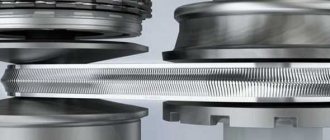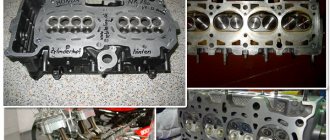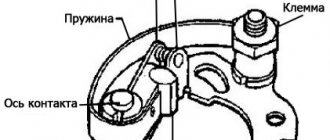When choosing the right oil for a car, people often do not notice the difference in the products, except for the labeling. Working at service stations, I often hear from my clients that it is better to buy 10W 40 semi-synthetic lubricant than to spend money on 5W40 synthetic lubricant.
I agree that the substances have similarities, but there are also differences between them. If you don’t know the difference between one composition and another, then it’s time to read my article. I will tell you how 5W40 oil differs from 10W40 oil, so that novice car owners can better navigate this issue in the future and fill the engine with the lubricant that is most suitable for the car.
What is hidden behind the motor oil markings?
First, let's look at the two-digit markings that are located on each canister of motor oil. This is the standard SAE marking, which is recognized by the vast majority of manufacturers around the world. In our case, oils 5W-40 and 10W-40 according to SAE - both compositions are all-season, they are prepared for operation at 100ºC engine heating and in the cold. Now a little more detail:
- The first digit (0, 5, 10, etc.) with W is responsible for winter viscosity, i.e. beyond the solidification threshold of the composition at the negative temperature for which the oil is designed. Marker W (from the English winter - winter) means that the oil is designed to work under cold start conditions, when the car, for example, spent the night in the cold and the engine has to be started cold. The higher the value, the more viscous the composition is, which means it flows worse when it gets cold and lubricates the moving parts of the engine worse, the oil filter has a harder time letting it through, etc. This indicator does not affect the operation of a heated system.
| For winter, the best prepared compositions are those marked 0W-40 (-40ºС), 5W-40 (-35ºС) and 10W-40 (-30ºС). |
- The second digit after the hyphen (20, 30, 40, etc.) is responsible for the viscosity at 100 ºC engine operation. The higher the temperature inside the engine, and the more the car heats up in the sun, the more liquid the oil becomes, and this is fraught with deterioration in performance, carbon deposits and leaks. Accordingly, the higher the value, the thicker the composition will be in the summer and with increased heating of the engine.
| 5W-40 and 10W-40 flow without problems in heat up to +40ºС |
The SAE marking is very conditional, and it is not always possible to determine only by it whether an oil is suitable for certain temperature conditions or not - here sometimes a more “subtle” approach to selection is required and selection according to other characteristics: API, ACEA, oil type and characteristics in the data sheet. But the main selection criterion is the manufacturer’s recommendation, which is indicated in the vehicle’s operating instructions.
Briefly about labeling
When choosing a lubricant suitable for an engine, the question often arises of which product to choose so as not to harm the engine. The main characteristics when choosing a suitable composition is the approval for the use of the substance.
The second point that you should also pay attention to is the thickness of the product. The thicker the lubricant, the better it will withstand heat, and vice versa. Oils 5w40 and 10w40 are all-season. Both compositions are very popular among motorists in central Russia and the southern regions. The marking indicates that the substance can be used at very low temperatures.
If you rely on the designation, then 5w40 is more universal than 10w40. The product can withstand low temperatures and ensures that the engine starts even when cold. In turn, 10w40 is a semi-synthetic, differing in the method of production. This type of grease should be used at higher temperatures. When the thermometer drops below -25 degrees, the engine may not start. As a result, we can say that lubricants differ in temperature of use.
What is better in terms of viscosity in winter - 5W-40 or 10W-40?
Based on the previous point, we found out that the difference between oils lies in their viscosity. Accordingly, 5W-40 and 10W-40 are distinguished by their fluidity in cold temperatures; their endurance at 100ºC when the engine warms up is almost identical.
| Why practically? Each composition has unique data on pour point, flash point, kinematic viscosity, etc., which can only be found by referring to its data sheet. |
5W-40 motor oil is better prepared for working in cold weather, although the “hot” data for both compositions are identical. In winter it can be used down to -35 ºС - at this temperature the manufacturer guarantees uninterrupted operation of the crankshaft and oil pump. The starter is guaranteed to start the engine at a temperature of -30ºС. This is the most universal oil, which is most often used by car enthusiasts in the middle zone. The 10W-40 composition has much less endurance at negative air temperatures. Oils with index 10W-40 lubricate and facilitate the operation of the crankshaft at temperatures down to -30ºС and the starter at -25ºС.
| Limit yield for crankshaft operation | |
| SAE Index | Threshold of stable operation |
| 0W | -40ºС |
| 5W | -35ºС |
| 10W | -30ºС |
| Limit fluidity for engine starting | |
| SAE Index | Threshold of stable operation |
| 0W | -35ºС |
| 5W | -30ºС |
| 10W | -25ºС |
Accordingly, you need to choose the ideal composition according to the climatic conditions in which the car will be used all year round. For cold climates, 5W-40 oil is suitable - it will ensure high-quality and safe operation at temperatures from +35ºС to -35ºС, this way you will slightly reduce fuel consumption and make it easier for the engine to operate during cold starts. For less severe conditions, use 10W-40, because it crystallizes already at a temperature of -25 ºС. However, due to its viscosity, it has a couple of advantages in conditions of heavy loads on the engine in the summer.
| It is also not worth taking oil with too high a viscosity - a protective film that is too thick conducts heat less well, which means the engine will overheat. Too liquid a composition will only lead to leaks and waste. The result is obvious - the same extra fuel consumption and wear and tear. |
Again, let’s make a reservation that these are very average values - real data should be looked at in the technical data sheet that each train has. Look for data on the manufacturer's official website. But all this is just a theory. Each type of engine has its own needs and, accordingly, recommended motor oils. It is more correct to select a lubricant composition based not on theoretical concepts, but primarily on the recommendations of the car manufacturer. All tolerances are specified in the machine operating instructions. And only if the manufacturer allows you to fill in both 5W-40 and 10W-40, choose according to your needs.
5w40 or 5w30: what to choose?
We've figured out what the difference between 5w and 10w is, now let's try to understand whether the difference between oils is significant when the differences lie in the second labeling indicator.
From the point of view of winter operation, both oils retain stable properties down to -30 degrees Celsius. They provide easy starting of a cold engine, efficient circulation of the working mixture and optimal protection of mechanisms from wear. Manufacturers of motor oils also note that in lower temperature conditions the operation of liquids is relevant, but it requires a more powerful source of energy capable of cranking the crankshaft when the oil is too viscous.
The climatic limit for the “five” is -45…-55 degrees. In this range, the working fluid completely solidifies.
In winter, it doesn’t matter what is poured under the hood: 5w30 or 5w40 oil. In critical conditions they will behave the same way.
Although both lubricants are classified as all-season lubricants, in hotter areas it is recommended to use a thicker oil during the summer. The viscous base has high temperature resistance and does not allow the film to simply run off from the structural elements of the power unit.
There is no difference in using oil with temperatures of 30 and 40 to thirty degrees Celsius. Both fuels and lubricants operate within the parameters stated by the manufacturer. If the specified limit is exceeded, the oil with a lower indicator will enter a phase of sufficient viscosity to drain from the engine components. “Defenseless” parts will aggressively interact with each other, forming severe overheating inside the motor. This effect is dangerous for the car due to jamming of the crankshaft, wear of the motor mechanisms and excessive consumption of the fuel mixture.
What kind of oil should I put in an old engine?
If the manufacturer recommends pouring both types of oil into the engine, then the question arises: what viscosity is suitable for a car with, for example, 100,000 km, which is already beginning to wear out? Since engine parts become loose over time and the gaps in them widen, to prevent leaks and carbon deposits, take compounds with a higher viscosity. Thick oil will form a wide protective layer, which will help the old engine do its job much longer and not burn out or leak.
| Since the 10W-40 composition is more viscous, it should be used in a used car. |
The main thing here is not to overdo it. After all, a more viscous composition puts more stress on the crankshaft and other parts. Before deciding to change the oil to a more viscous one, check the vehicle's operating instructions.
Results
It’s good when the car’s engine system works properly and efficiently, but for this it is necessary to answer the question: “What is the difference between 5w40 oil and 10w 40?” and “which oil is thicker 5w40 or 10w 40.” Each brand of vehicle has its own motor fluid capable of restoring and maintaining high performance properties. And it can only be determined with the help of the car manufacturer. Having figured out the difference between 10w40 and 5w40, do not rush to pour them under the hood of the vehicle, but first read the requirements of its operating manual. If it states that the use of a specific viscosity is prohibited, do not neglect this rule. Perhaps it will save you from expensive car repairs.
Is it possible to mix motor oils?
You can mix formulations of different viscosities, but only if there is simply no other choice. For example, if a deficiency is discovered, but the trip cannot be postponed. Then it is possible to add, for example, a little 10W-40 to the 5W-40, so that the engine does not run dry - and this is the worst thing.
| In general, there is no categorical prohibition on mixing two compounds - the additive packages for synthetic and semi-synthetic compounds are approximately the same. |
What you definitely shouldn’t do is mix oils of different base types - for example, a mineral composition with a synthetic one. In theory, synthetics and synthetics from the same manufacturer can be mixed and this will definitely not cause serious problems. In addition, all oils undergo the same compatibility tests, and if its composition does not pass, it simply will not be given a certificate and will not be assigned an API index. The problem here is that manufacturers keep the exact data on the composition of oils secret, this is a company secret and nothing can be done about it. Therefore, it is quite difficult to accurately predict what will happen to the engine if oils with different data are mixed in it. In an engine, oils with different viscosities will inevitably enter into a chemical reaction with each other, but how this will end is a field for experimentation, but would you want to experiment with your own engine? This certainly won’t kill it, but long-term use of a mixed composition will inevitably make itself felt by increased consumption, carbon deposits or an increased degree of wear. Therefore, at the first opportunity, you should go to a car service center, completely drain the old fluid from the car, change the oil filter and fill in new, clean oil.
| Remember that you can only mix oils from the same manufacturer. This way you can at least be sure that there will be liquids with a similar composition inside the engine. |
How to choose the optimal lubricant - what to look for when choosing?
Since there are many differences between lubricants, it is important to make the right choice. This is good for the motor and less hassle for the owner. It is worth giving a few tips that will allow you to choose the right oil for your internal combustion engine. There are a number of factors that play a determining role in this matter.
Let's look at the information in more detail:
- see the list of approvals from the engine manufacturer;
- take into account the mileage of the car and the condition of the internal combustion engine;
- The climatic conditions of the car’s operation matter;
- It is also important to focus on the year of manufacture of the vehicle;
- take into account the loads placed on the motor during operation.
Some experts recommend buying the liquid that was filled in by the manufacturers when purchasing the car. Typically, original substances are much more expensive than analogues, but the quality is also higher.
When choosing a composition, it is better to compare all the listed characteristics and choose the product that is best suited for a particular vehicle. Be sure to check quality certificates for lubricants. Buying a counterfeit product will result in serious damage to the engine.
But what about the transition from one oil to another?
Knowledgeable drivers will immediately object that the oil in the engine cannot be completely “clean”, and in any case the liquids are mixed during the seasonal oil change. And they will be right. This is especially true for those who are going to fill a car with a different type of composition - synthetics instead of mineral water, for example. Or when moving to another region where a composition with different properties is required.
| For cold temperatures, it is possible to slightly reduce the value after W, i.e. take 30 in place of 40. This way you will slightly reduce fuel consumption while the engine warms up. The same should be done for urban conditions. |
Indeed, no matter how thoroughly the engine is drained and cleaned with flushing oils, 3-5% of the lubricating fluid will still remain on the cylinder walls and in the most inaccessible corners. This means that mixing of oils, even in small volumes, will definitely happen, and it’s hardly possible to do anything about it, and it’s not really necessary. The main thing is to follow the oil change schedule and do not let the car run on an old composition with a spent resource. Then mixing the waste residues with the new lubricating fluid will definitely be harmless, even if you did not use flushing.
| In any case, it is better to use oils from one manufacturer: this way you will reduce the risk of a reaction with unpredictable consequences. For example, if you drove with Shell brand oil with a viscosity of 10W-40, then fill in 5W-40 oil from the same Shell and safely start the engine. |
Features during operation.
You should adhere to the basic rules for changing motor oils:
- try to avoid frequent changes of manufacturers - products from different brands differ significantly in composition and quality;
- when 5w40 oil is partially used up, it can be topped up with 10w40 oil, only produced by the same brand. Otherwise, there is a danger of disruption of the interaction of additives;
- You can mix oils of these two brands when topping up, but only as a temporary measure, since prolonged use of such a mixture results in increased wear of parts.
Engines that convert the energy of burning fuel into mechanical energy (ICE) operate, as a rule, in two liquid environments. This is external (water jacket) cooling, heat removal, and its uniform distribution occurs due to the forced circulation of coolant.
The second liquid medium that ensures normal engine operation during long-term operation is the lubrication of rubbing surfaces using engine oil moving inside the engine under pressure from an oil pump.
The performance, efficiency and durability of the engine under various operating conditions largely depend on the quality of the engine oil and its manufacturing method.
Synthetic or semi-synthetic
Currently, the most popular motor oils are 5w40 and 10w 40, let’s look at the difference between them. First of all, they are distinguished by the production method; 5w40 is produced by deep oil refining and is synthetic, since it does not contain mineral components.
The performance qualities of synthetic oils are higher and they are more expensive. Oil 10w 40 is also produced using a deep cleaning method, but it contains mineral components along with components from deep cleaning.











